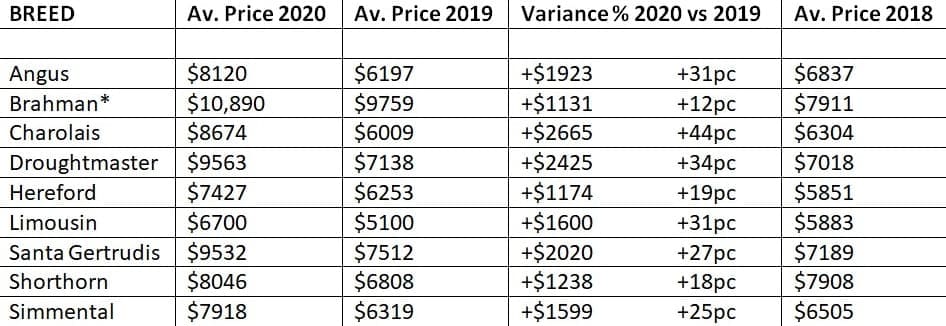WHAT a memorable year 2020 has proven to be for seedstock producers across Australia.
Fuelled heavily by herd rebuilding across large parts of the country after drought, and a restocker and slaughter cattle market that has ‘known no boundaries’, bull breeders have ridden a wave of producer confidence to re-set the bar for all major metrics for the industry.
With final bulls sales in Central Queensland only completed in recent days, all major beef breeds have recorded substantial-to-dramatic growth in average prices paid for bulls, clearance rates of bulls offered, and numbers of bulls sold.
Beef Central’s annual analysis of bull sales, published each year since our business was launched in 2011, is set out in detail below. The analysis takes into account auction sales, nation-wide, for bulls from the nine largest beef breeds in use across the country. Paddock sales, which make up a very large portion of bull sales for some tropically-adapted breeds, are not included, as they are simply impossible to accurately record. This also explains the absence of breeds like Wagyu, which while significant by industry standards, sell virtually no herd bulls in the auction ring, and uses a disproportionately large amount of artificial breeding.
The report is divided into two portions – this article, which focuses on average prices paid, and a second article (click here to access) which examines changes in the numbers of bulls sold for each breed, and clearance rates.
The record-setting 2020 bull selling year comes after the drought-plagued 2019 year, which still performed much better than expected for most breeds, due to the strength of last year’s slaughter and live export cattle market.
This year’s results provides an encouraging sign for the genetic material on which commercial beef producers are rebuilding their future, now that the recent phase of herd reduction is completed. In sheer female statistical terms, bull covering requirements are still considerably less than what they were three years ago. MLA estimated the national beef herd at 24.7 million head in June – down about 12.4pc on the same period two years earlier, and the lowest herd size since 1992.
Is the 2020 result a one off?
The question is now being asked: Were the 2020 bull sale results a one-off, or are current prices and numbers sold levels the new normal?

Alastair Rayner
Beef Central genetics editor Al Rayner thinks two inter-related factors will influence that: the strength of the store and slaughter cattle markets next year, and the seasonal conditions. Declines in either (or both) would almost inevitably see some retraction in bull prices next year.
In a report published yesterday, AuctionsPlus chief market analyst Tim McRae suggests cattle prices might fall by 30pc by the end of next year, if the predicted La Nina wet season event fails to deliver.
Mr Rayner said while buyer confidence, driven by cattle prices and seasonal conditions, would continue to drive the bull market, there was now also also a clear recognition that there was a ‘value’ for bulls that is higher than what has traditionally been applied by buyers.
“It’s unrealistic to expect that bull prices will simply retract to pre 2019-20 levels. The days of the $5000 bull should be well and truly gone, given the time, money and effort that goes into producing quality genetics required to lift commercial herds. People now recognise that they need to be prepared to pay a reasonable price to truly lift herd progress.”
Background
Ten years’ worth of Beef Central data clearly shows that two key attributes drive breed-scale bull sale performance: seasonal conditions and commercial cattle prices. In years when both are in favour, like 2016-17, prices hit historically high levels, underpinned by buyer confidence. When either is lacking, results are impacted, to varying degrees.
For example there is a clear correlation between the start of Australian beef’s current cattle price ‘boom’ cycle in mid-2015, carrying through to today, with better average bull prices. It appears that seasons, on the other hand, tend to have a greater bearing on the number of bulls sold, and clearance rates achieved.
Firstly, a caveat on the statistics provided in today’s reports. Several breeds have reported that a small number of studs were unwilling to share their results for 2019 sales – presumably because their outcomes were disappointing, due to drought.
That will inevitably skew results a little for those breeds, in two ways. It will artificially inflate average price, and potentially under-report the number of bulls sold a little. We’re confident that the statistical impact is only minor, however, given the modest numbers of ‘unreported’ bulls involved.
A total of 345 auction sales of bulls in the nine represented breeds were held this year, in all five mainland states, plus Tasmania and the Northern Territory, Beef Central’s bull sales summaries show.
‘Boom year’ for average prices paid for bulls
The 2020 bull selling year, taking both autumn and spring sales into account, shows that all nine recorded beef breeds displayed dramatic rises in average price for bulls sold at auction.
As the table published here shows, breeds rose in value, year-on-year, by between $1174 (Hereford) to $2665 (Charolais). In percentage rise terms, rises from 2019 to 2020 ranged from 12pc (Brahman) to an incredible 44pc (Charolais).
Average price, 2020 sale bulls
As is always the case with sets of figures like this, they need to be put into some context.
The $10,890 average price for the 2135 Brahman bulls sold this year is unprecedented, and an extraordinary result for a breed of this size.
The ‘moderate’ percentage rise over the 2019 Brahman result of just 12pc can be explained by the fact that Brahmans in fact had an unusually strong year last year, as well. Last year’s average price for Brahman bulls was $9759 – itself a record for any breed up to that point, and almost $2250 more than the next highest breed in 2019.
 Brahman bull breeders notched up an incredible 27pc increase in value on 1893 bulls sold at auction in 2019, over the 2018 year. In an incredibly dry year, that result was fuelled by record high commercial cattle and live export prices. The previous high point for Brahmans – or for any breed for that matter – was the 2016 year when the breed averaged $8688 for a total of 2321 bulls sold – considerably more bulls sold than this year.
Brahman bull breeders notched up an incredible 27pc increase in value on 1893 bulls sold at auction in 2019, over the 2018 year. In an incredibly dry year, that result was fuelled by record high commercial cattle and live export prices. The previous high point for Brahmans – or for any breed for that matter – was the 2016 year when the breed averaged $8688 for a total of 2321 bulls sold – considerably more bulls sold than this year.
Worth noting, also, is that unlike most other breeds, the Brahman result this year included about 7pc of the offering that were unregistered herd bulls. The 151 Brahman herd bulls sold in 2020 averaged $5974, a little more than half the price of the remaining 1984 registered bulls, which averaged $11,264. If ever there was a motivation for registration of herd bull calves, this is it.
Australian Brahman Breeders Association manager Anastasia Fanning said continued strength in cattle prices, both for meatworks cattle and live export, had helped underpin confidence this year among bull buyers, despite the continued dry conditions across large parts of Queensland, the Northern Territory and northern parts of WA.
No breed is as heavily exposed to the live export industry as Brahmans, and continued strong demand out of Indonesia for lighter cattle, and Vietnam for heavier cattle, has underpinned trade, with Indonesia steers currently ex Darwin currently worth a record 390c/kg liveweight, up 70c/kg on this time last year. And with vessels now routinely loading from ports as far south as Port Alma, near Rockhampton, a greater proportion of Brahman-influenced cattle are exposed to live export competition.
Other breeds producing solid gains in average price this this year included Droughtmasters, averaging $9563, up $2425 or 34pc on last year; Santa Gertrudis, averaging $9352 this year, up $2020 or 27pc on last year; and Charolais, averaging $8674 this year, up $2665 or 44pc on last year.
31pc rise in Angus ‘somewhat surprising’
Angus, easily the largest breed by numbers of bulls sold at auction with 8646 head (see today’s separate story) averaged $8120 this year, up $1923 or 31pc on the year before (editor’s note: this figure may adjust slightly, as last week’s Gandry sale in WA is still to be recorded). The figure is a record high for the Angus breed.

Peter Parnell
Angus Australia chief executive Dr Peter Parnell said the big 31pc increase in Angus average prices in 2020 was somewhat surprising, following the expected reduced demand for bulls following the shrinkage of the national breeding herd after the prolonged, severe drought.
“It is undoubtedly a reflection of the high level of confidence that commercial producers have in the beef sector, boosted by record commercial cattle prices for quality Angus cattle during 2020,” he told Beef Central.
“The bull sale results clearly indicate that this confidence has led to a willingness by commercial breeders to invest in high quality genetics as part of their post-drought herd rebuilding programs,” Dr Parnell said.
Seasonal psychology of buying bulls
As this report has discussed in past years, there’s also a theory that bull buyers, especially in the northern half of the continent, tend to think defensively in their bull purchase decisions during dry times, opting for breeds offering environmental adaptation over meat quality or fertility. That may partly explain the popularity of Brahman bulls (as evidenced by average price) last year.
Conversely, in above average seasonal years, the theory is that appetite is more likely to grow for British or Euro breed options. The counter-argument to that, of course, is that it’s going to be almost 12 months before calves from bulls bought in spring 2020 hit the ground, and two years or more before many are sold, by which time today’s seasonal conditions are likely to be long gone.
2021 autumn bull sales marketing
 Stud managers wishing to promote their Autumn 2021 bull sales via ads on Beef Central’s genetics pages, daily email alert or home page early next year should contact business development manager Rod Hibberd (pictured) at rod@beefcentral.com or phone on 0437 870 127. Ad spaces are limited, so make contact early to avoid disappointment.
Stud managers wishing to promote their Autumn 2021 bull sales via ads on Beef Central’s genetics pages, daily email alert or home page early next year should contact business development manager Rod Hibberd (pictured) at rod@beefcentral.com or phone on 0437 870 127. Ad spaces are limited, so make contact early to avoid disappointment.
Soon after Christmas, work will also start on compiling the full list of 2021 Upcoming Bull Sales, appearing as a tabulated list in Beef Central’s genetics section. We remind studmasters to submit their 2021 autumn sale dates early next year (via this form), if they are not already provided by respective breed societies.

